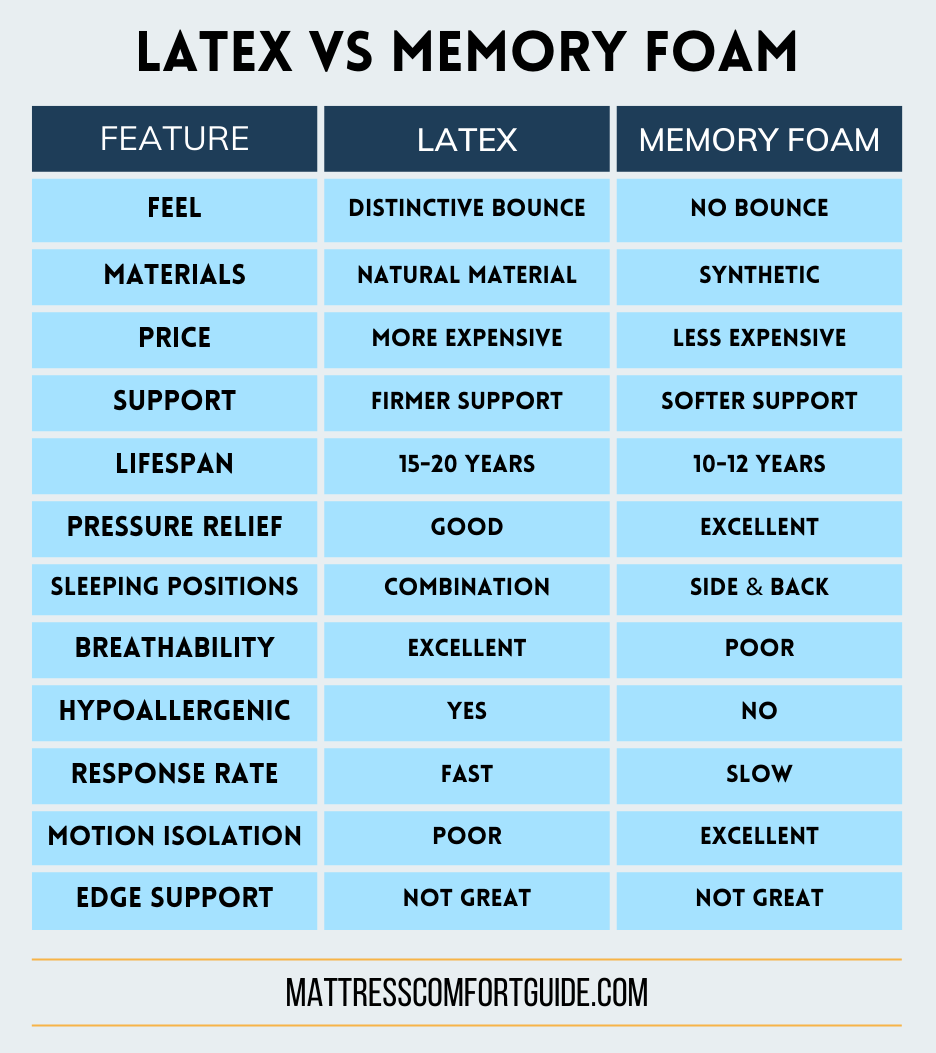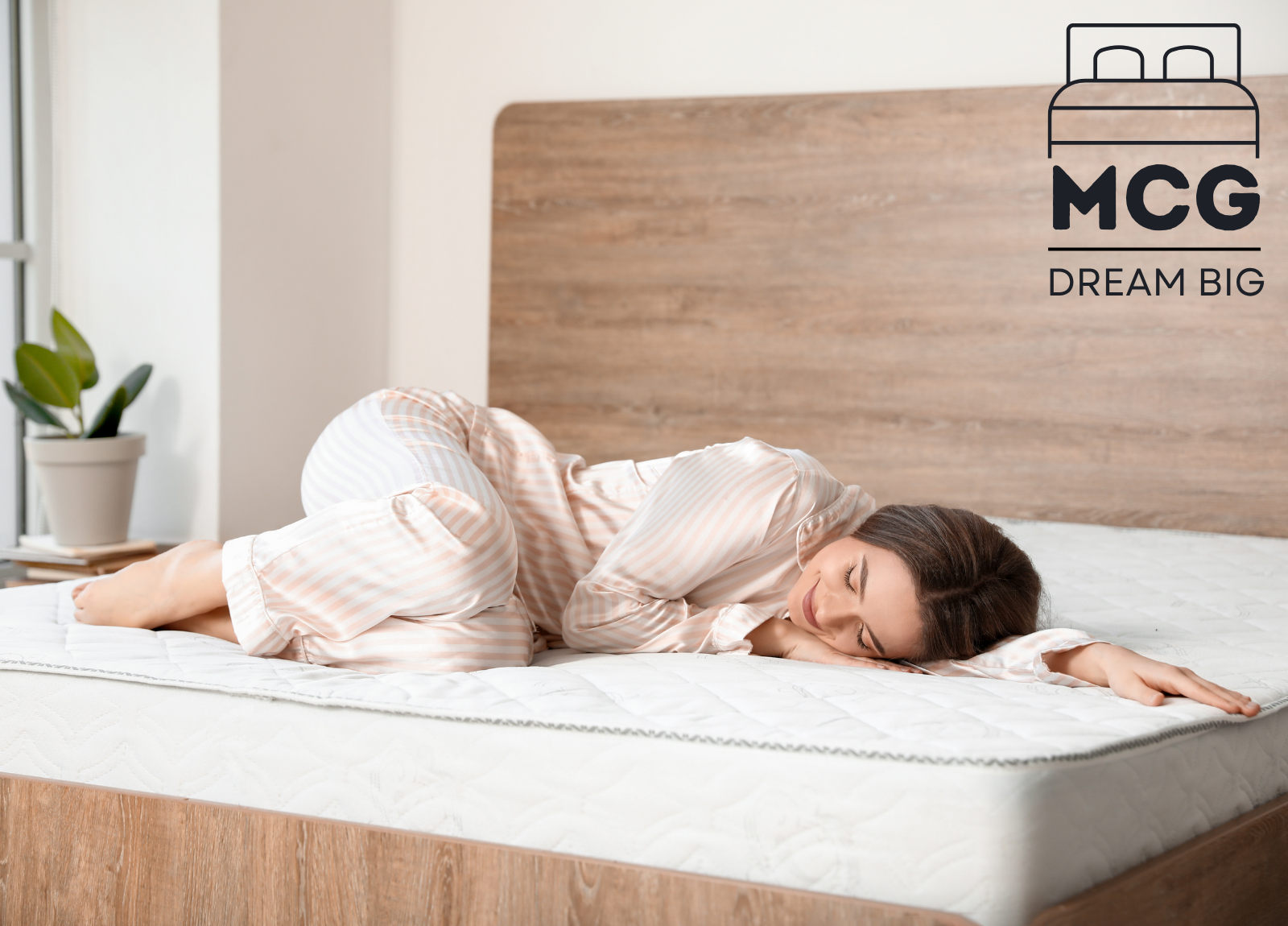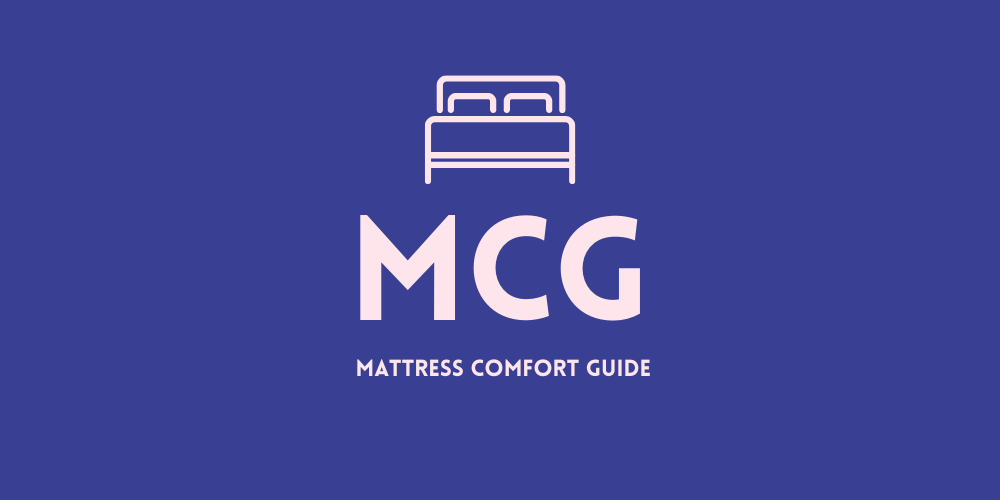
What’s better – a latex or memory foam mattress? Each has a set of distinct characteristics and to figure out which one is better, you need to compare these features against your unique preferences and specific needs. This article covers everything you need to know about – Mattresses Latex vs Memory Foam. We examine each feature of these mattresses and compare how both types perform. You can then match these comparisons against your sleeping needs. You can use the links below to get straight to what you need.
Mattresses Latex vs Memory Foam
Are you considering buying a new mattress? Need to get some more information on how a latex mattress compares to a memory foam? You’re in the right place. We cover everything you need to know. Use the links below to get to what you want – quickly.

Jump to Content
• Support
• Expected Lifespan
• Pressure Relief
• Sleeping Positions
• Breathability & Temp. Regulation
• Hypoallergenic
• Response Rate
• Motion Isolation
• Edge Support
Feel
The main difference between a latex mattress and a memory foam is the feel. The two mattress types feel completely different. A latex mattress has a distinctive bounce. When you lay on a latex foam mattress it quickly changes shape to cushion your body. Memory foam on the other hand has no bounce and a very slow response rate.

This means it gradually changes shape in response to pressure to contour your body and relieve pressure. Latex mattresses are better for people that like support and responsive movement. Memory foams work best for people that prefer motion isolation and no bounce in their mattress. Which feels better? It all comes down to personal preference.
Materials
If you’re looking for a mattress that is made from natural materials, then a latex mattress is the clear winner in this category. Latex mattresses are made using the sap of the rubber tree. It is a completely natural material and latex mattresses are often available in 100% organic varieties. Mmeory foam mattresses on the other hand are made from synthetic materials.
The foam is manufactured by blending polyurethane plastic and a combination of petrochemicals. The firmness level of both latex and memory foam mattresses can be adjusted by tailoring the manufacturing process and preparation of the source materials.
Price
Price is one of the first things we look at when shopping mattress options. And, when it comes to price, we have a clear winner in the latex vs memory foam match-up. Latex mattresses are more expensive compared to memory foam. They are made from natural materials and are a higher quality, luxury product. However, they are also more durable. You can expect a latex mattress to last many years and provide more serviceable years compared to a memory foam. A tasty long-term investment.
RELATED
Support
Which mattress type provides better support – latex or memory foam? In essence, they both deliver excellent support. Latex mattresses are often firmer and have a distinctive bounce. This means they are great for average-size and larger individuals that require a mattress that can easily support their body weight and assist movement throughout the night. Memory foam mattresses tend to be softer. So, they work best for average weight and light weight individuals.
Expected Lifespan
How long do they last? Latex mattresses are more durable than memory foam mattresses. Latex foam is incredibly robust and if treated with care it will last many, many years. It’s not uncommon for a latex mattress to last up to 20 years.

Memory foam mattresses on the other hand tend to break down more quickly. The foam structure is more susceptible to wear and tear. Memory foam mattresses are more difficult to maintain and care for. A good quality memory foam mattress will typically last 10 years.
Pressure Relief
Both latex and memory foam perform well in terms of pressure relief. But, memory foam edges it. Memory foam has the ability to change shape in response to pressure. This allows it to closely contour the body and provide excellent pressure relief. It’s a great choice for people with aching joints that need relief for the knees, hips, and shoulder areas while sleeping. Latex has a bouncier feel and although it delivers good pressure relief, it doesn’t quite perform as well as memory foam.
Sleeping Positions
What about sleeping positions? Do you have a preference? Which is better for your preferred sleeping position in the latex vs memory foam showdown? Memory foam works best for people that tend to stay in one position throughout the night. And, latex is better for combination sleepers – those that change position while they sleep.
Memory foam changes shape to contour the body and provide pressure relief. This works great for side and back sleepers. The natural bounce of a latex mattress provides greater support and assists movement, making it easier to change sleeping position during the night.
Breathability & Temperature Regulation
Breathability refers to the ability of a mattress to allow hot air to escape the surface of the mattress and regulate temperature. If you are a hot sleeper, breathability and temperature regulation are important features in a mattress. And, latex is the clear winner in this category. Latex foam is a naturally breathable material. Air can pass freely through the foam and this helps regulate temperature and keep you cool. On the other hand, memory foam tends to trap heat and can lead to an uncomfortably hot night’s sleep.
RELATED
• Best Latex Mattresses – Independent Reviews
• Best Memory Foam Mattresses – Independent Reviews
• What Is a Memory Foam Mattress?
Hypoallergenic
Hypoallergenic refers to materials that are less likely to trigger an allergic reaction. And, when it comes to latex vs memory foam, latex mattress comes out on top. Latex is a naturally hypoallergenic material. It is sourced from the sap of the rubber tree and whipped up to create a foam used in mattress production. Latex mattresses are less likely to trigger an allergic reaction compared to memory foam. Memory foam is made from synthetic materials that can harbor and attract dust mites and other allergens.

Response Rate
Response rate refers to a mattress’s ability to change shape in response to pressure. Latex mattresses have a much faster response rate than memory foam. They rapidly change shape when you lay on the mattress surface. And, they quickly bounce back to their original shape when you climb out of bed. Memory foam has a very slow response. This means it gradually changes shape when pressure is applied. And, when pressure is removed it slowly returns to its original shape. Memory foam mattresses tend to sag over time.
Motion Isolation
Motion isolation is the ability of a mattress to absorb motion without transferring it to other areas of the mattress. Latex mattresses demonstrate poor motion isolation. A movement made on one side of a latex mattress can be felt on the other side of the bed. Memory foams demonstrate excellent motion isolation. This type of foam absorbs motion and isolates it. A movement made on one side of a memory foam mattress creates very little movement on the other side – a great feature for couples sharing a bed.
Edge Support
Both latex and memory foam mattresses provide limited edge support. This means, when you sit on the edge of one of these mattresses it tends to bend and roll away from the bed. Firm memory foam mattresses provide marginally better edge support compared to latex mattresses. However, if you want a mattress with prominent edge support you should take a look at hybrid and innerspring mattresses. These mattresses use reinforced spring edges to provide additional strength and support to the mattress perimeter. In short, there is no clear winner for edge support in the mattresses latex vs memory foam contest.
READ NEXT
• How Long Does a Latex Mattress Last?
ABOUT THE AUTHOR
JESSICA GABEL – MCG Contributor
Jessica joined the MCG team in 2021 and is our in-house sleep expert. She is a fountain of knowledge on sleep cycles, sleep hygiene, and sleep-related disorders. Jessica is a graduate of the College of Arts and Sciences at the University of New Mexico and holds a B.S in Sociology.
When she’s not educating us on sleep-related matters she is continuing her studies at the University of Arizona. Outside of work and study, Jessica likes to explore the great outdoors. Her favorite places to visit include the White Sands National Park, Chaco Culture National Historical Park, and the Carlsbad Caverns National Park.
